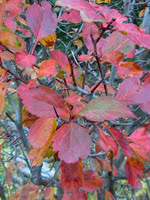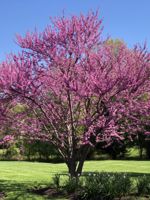Mon-Fri 9am - 5pm Mountain time
Black Hawthorn vs Eastern Redbud
Crataegus douglasii
Cercis canadensis
NOT AVAILABLE THIS SEASON - MIGHT RETURN
Black Hawthorn is a versatile plant that is native to wetlands and other areas with moist soils, but can also tolerate dry soils. This plant can be grown as a short shrub, or a tree reaching 30 feet tall.
Black Hawthorn is valued for erosion control and attracting pollinators. It also makes an attractive flowering ornamental that can be planted as a specimen or pruned as a hedge. It is commonly used in shelterbelts.
The Eastern Redbud is known for the pea-like pink buds that emerge in clusters on the bark, embellishing the tree in stunning flowers. They have a longer bloom time, sometimes for two to three weeks before the heart-shaped leaves emerge for the summer. Inedible pods emerge that turn brown in the summer, this tree is a part of the bean family.
Native to the Eastern North America. The Eastern Redbud can tolerate acidic and alkaline soil. Plant this as a beautiful understory species or shaded residential yard or garden. The bright pop of color will make an attractive ornamental tree.

